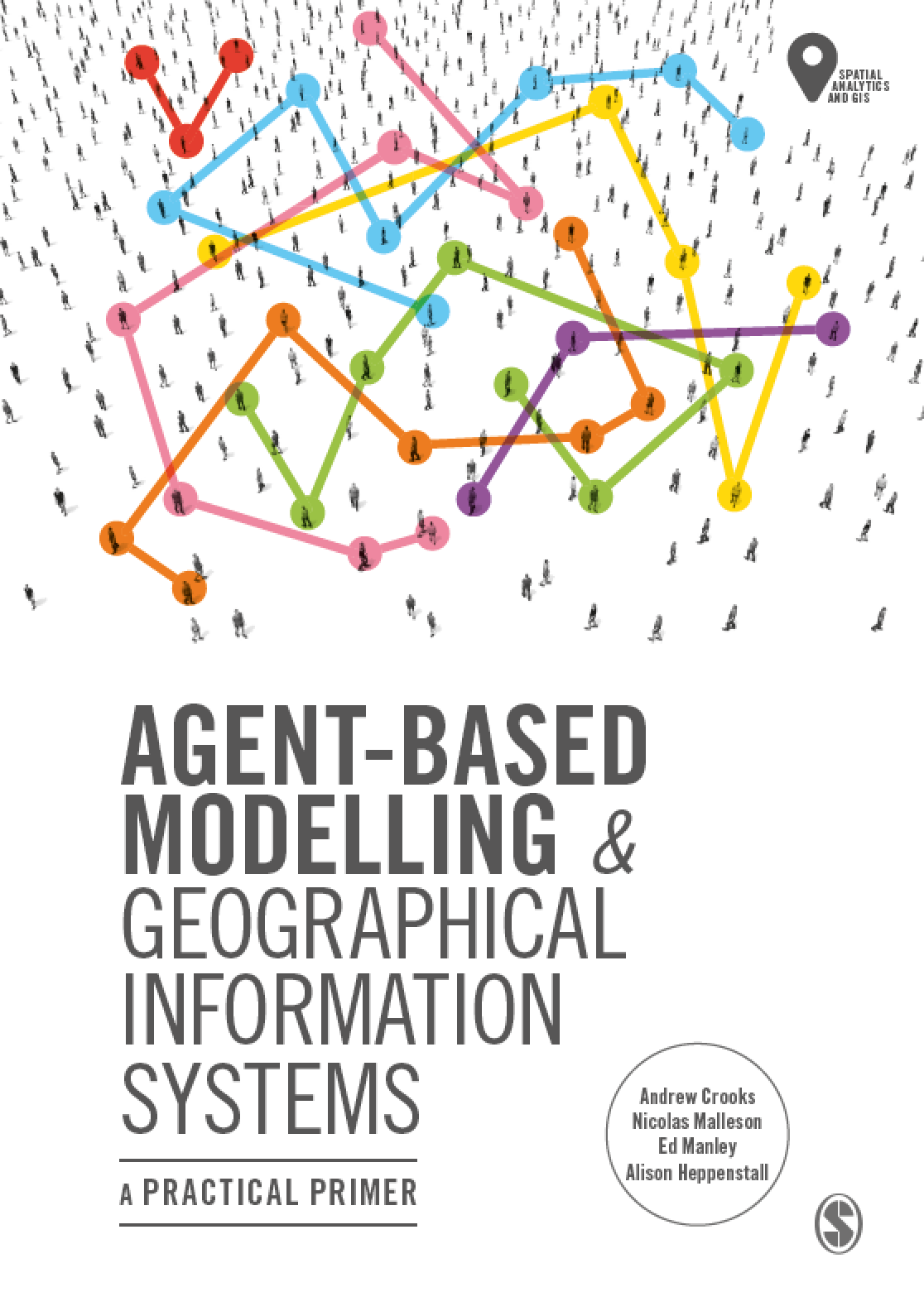Agent-Based Modelling and Geographical Information Systems
A Practical Primer

Agent-based models - computational models that simulate complex social interactions - have become a well established simulation tool in the social sciences, but until recently their potential within the spatial sciences has been limited. This pioneering text, pulled together by an expert team of authors demonstrates how agent-based modelling can be integrated with geographical information systems (GIS) to produce new insights on complex geographical phenomena, from patterns of urban growth to trends in mobility, population dynamics and health.
Providing step-by-step guidance and packed full of practical examples, Agent-Based Modelling and Geographic Information Systems will show you:
- The fundamental theory and potential applications of agent-based modelling
- How to design, develop and build agent-based models
- The how and why of integrating agent-based modelling with GIS
- How agent-based models allow us to study connections between people and places
- How to evaluate agent-based models
Supported by an online code repository and additional materials, enabling you to walk through the examples in the text, this book will give you the essential knowledge and practical skills required for building and running your own agent-based models for simulating geographical systems.
Endorsements
“A highly original textbook linking complex systems and agent-based modeling with GIS using theoretical and methodological perspectives, software implementations, and real-world applications. A much-needed book for students at all levels to learn about geosimulation and modelling with geographic automata.”
Suzana Dragicevic, Simon Fraser University
“A great introduction for all those interested in learning about agent-based simulation where physical space is an important factor. Importantly this integrates GIS and other common geographic approaches with simulation approaches. Both beginners and more advanced researchers will find a lot of useful information here.”
Bruce Edmonds, Manchester Metropolitan University
“This textbook is a must-have for everybody who wants to learn or know about agent-based models integrated with geographic information systems. It combines in-depth introductions to basic concepts with hands-on advice on technical detail and covers all relevant aspects.”
Volker Grimm, Helmholtz Center for Environmental Research - UFZ
“I fully expect to recommend individual chapters to students when they come to me with detailed questions, when they need a refresher on some of the concepts, or when they show specific knowledge gaps that need to be filled in.”
Julia Kasmire, University of Manchester
“The textbook shows an interesting and innovative way of approaching the themes of scientific research in architecture courses. On the one hand, it introduces the theme of agents and behaviour modelling, on the other, it allows consistent use of GIS in an academic environment, with immediacy and effectiveness.”
Marco Spada, School of Arts and Humanities, University of Suffolk Manchester
“Crooks et al pave the way to agent-based modeling in an understandable and motivating way for my students. As a lecturer, I am able to structure my teaching units very well according to the book and link a number of sections of this book with concrete activities in the seminar. Therefore, this book is also a very good support for me, which I would like to recommend to other lecturers.”
Wolfgang Kotowski, Aberdeen Business School, Robert Gordon University Manchester
Book Outline
Below you cand read the chapter outlines for Agent-based Modelling and Geographical Information Systems: A Practical Primer In addtion to this for each chapter we provide a link for accompanying resources (e.g. teaching material, models and tutorials).
Chapter 1: Agent-based Modelling and Geographical Information Systems
The overarching aim of this chapter is to give the reader a contextual backgroundand general overview of the major developments in geographical modelling for thesimulation of the individual. The reader is introduced to a discussion around thepurpose of modelling as well how complexity theory has influenced the way thatwe view (and simulate) geographical systems. We end the chapter by discussingthe benefits of bringing together agent-based modelling and GIS.
Click here to find accompanying resources for Chapter 1.
Chapter 2:Introduction to Agent-based Modelling
This chapter we introduce the key concepts behind agent-based modelling. What is an agent, and what are rules? These are discussed along with a consideration of the main advantages and disadvantages for simulating spatial systems. A range of established applications are presented to give a flavour of how agent-based models can be successfully applied. The overarching aim of this chapter is to give the reader an understanding of what an agent-based model is. This knowledge will be built upon in subsequent chapters.
Click here to find accompanying resources for Chapter 2.
Chapter 3 - Designing and Developing an Agent-based Model
What are the questions that social scientists and geographers need to consider when designing and building an agent-based model? What design frameworks and software toolkits are available to use? What are their relative pros and cons? What methods are available for documenting design concepts and why are they useful to modellers? This chapter will introduce the core concepts and frameworks that can be used to plan, implement and disseminate geographical agent-based models.
Click here to find accompanying resources for Chapter 3.
Chapter 4 - Building Agent-Based Models with NetLogo
This chapter provides an overview of the programming language and concepts that are used within NetLogo. NetLogo basics, such as how to create a simple environment, commands and procedures, are presented with step by step instructions for creating a simple model. Following this basic model, more advanced features are introduced. The overall aim of this chapter is to provide an understanding of the main components that make a NetLogo program. Subsequent chapters build upon the basics presented here.
Click here to find accompanying resources for Chapter 4.
Chapter 5 - Fundamentals of Geographical Information Systems
This chapter presents the main concepts and terminology that students are required to understand geographical information systems. The main data types are presented, along with a discussion of relevant issues such as accuracy and precision. A brief overview of the development of GIS is given along with a flavour of the main software available. Using QGIS, we demonstrate how to prepare and manipulate some example GIS data. Where appropriate, we highlight the main issues that need to be considered when using a GIS and agent-based modelling.
Click here to find accompanying resources for Chapter 5.
Chapter 6 - Integrating Agent-Based Modelling and GIS
Building on previous chapters outlining the fundamentals of GIS and agent-based modelling, what are the benefits to linking these approaches? How is this undertaken? This chapter will explain loose and tight coupling, critiquing the relative advantages and disadvantages of both. We present an overview of open source toolkits that can be used for the creation of geographically explicit agent-based models, before providing a critical look at where and how GIS and ABM should be combined, offering practical advice on best practice.
Click here to find accompanying resources for Chapter 6.
Chapter 7 - Modelling Human Behaviour
This chapter explores the most common approaches by which researchers incorporate human behaviour into agent-based models. We explain why it can be necessary to model human behaviour and the main considerations that the researcher needs to be aware of when developing an agent-based model. From this, we present an overview of the two main broad approaches, mathematical and conceptual cognitive models when it comes to modelling human behaviour in agent-based models. We supplement this discussion with two case-studies that provide examples of how these approaches can be implemented, both examples have the model code available that can be downloaded and experimented with. The chapter finishes with a discussion of some of the thorny issues that researchers need to be aware of when attempting to simulate behaviour within agent-based models.
Click here to find accompanying resources for Chapter 7.
Chapter 8 - Networks
Networks play a critical role in our lives in terms of physical networks we use to navigate upon, our social networks and more recently how we communicate via cyber networks (e.g. social media). This chapter provides a brief introduction to such networks and shows how they can be integrated into agent-based models. Importantly, a model is also introduced that demonstrates how to navigate agents along a physical road network (this is a common requirement for spatially-explicit agent-based models).
Click here to find accompanying resources for Chapter 8.
Chapter 9 - Spatial Statistics
This chapter presents a range of statistics and algorithms that can be used to compare two spatial data sets. These are important for modelling because, at some point, it will be necessary to compare a model outcome to some real-world data in order to assess how reliable the model is. This chapter examines the statistics themselves, before Chapter 10 elaborates on how to evaluate the success of a model more broadly, part of which includes making use of the methods discussed here.
Click here to find accompanying resources for Chapter 9.
Chapter 10 - Evaluating Models: Verification, Calibration, Validation
Model evaluation is one of the central challenges associated with agent-based models. A key question that all modellers face is “how well does this model simulate the phenomenon of interest?”. While there are no universally accepted methods for evaluating agent-based models, researchers often adopt the same three stage process of verification, calibration and validation. This chapter presents an overview of the methods that are commonly used within each of these stages. The overarching aim of this chapter is to provide the reader with the knowledge to design their own approach to evaluating agent-based models.
Click here to find accompanying resources for Chapter 10.
Chapter 11 - Alternative Modelling Approaches
Agent-based modelling is one of the most popular approaches used in social and spatial simulation. However, there are several alternative approaches that are available, including: Cellular Automata (CA); Microsimulation; Discrete Event Simulation (DES); System Dynamics (SD); and Spatial Interaction models.
This chapter presents an overview of these other approaches giving simple examples on how they can be used and summarising the main differences between them. To compare these models, they are applied to the same issue, the spread of a disease using a Susceptible-Infected-Recovered (SIR) epidemic model. This shows that while the same general patterns emerge, the reasons for this are very different.
Click here to find accompanying resources for Chapter 11.
Chapter 12 - Summary and Outlook
This chapter reflects on the current state of the art of agent-based models and factors that may shape the future of this discipline. Specifically we discuss the key challenges for developing robust agent-based models of geographical systems as well as potential solutions. We argue that we need to make progress on these challenges if these models are to be used to offer insight into key societal challenges, for example climate change, urban growth and migration.
Click here to find accompanying resources for Chapter 12.
Appendix A - A Gallery of Applications
While the entirety of this book has given a readers a selection of models (mainly in NetLogo) with respect to agent-based modelling more generally and linking such models to real world geographical information. We thought it would be useful for readers to have exposure to agent-based models developed not only with NetLogo but also other toolkits. In this appendix we provide a gallery of applications from a broad section of elds that have been published in the literature or act as exemplars for getting started with agent-based modelling. The criteria for inclusion here is that the source code and data of the model is available and it is based on real world geographical information. In each case we provide a screen shot of the graphical user interface of the model, a short description of the model, its full citation where possible and where the model (and data) can be downloaded from. Our hope is that the models provide readers with exposure to the possibilities of agent-based models and its potential for analysing a wide array of geographical systems and also share their own models and data.




